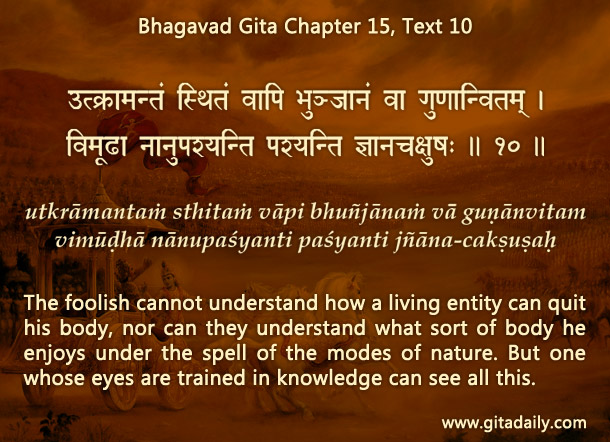People ask, “Can you show me the soul?”
Yes, answers Gita wisdom. But it underscores that we need to see intellectually before we can see visually. Let’s understand with an example from medicine.
If congenitally blind people gain vision through some treatment, their initial experience of sight is not illuminating but disturbing. As they have never seen anything before, they just can’t make sense of the splashes of shapes and colors that confront their eyes.
For example, when an acquaintance talks with such people, they turn towards the source of the voice and just see an unrecognizable pattern of outlines and shades. Only because they know beforehand that voices come from faces do they infer that the pattern in front of their eyes is a face. And because that voice is familiar, they infer that pattern to be the face of their acquaintance.
Consider another example: Blind carpenters who gain vision gaze at a hammer with a blank look. Only when they touch it, as they are habituated to, do they recognize it and start handling it with their usual deftness.
The point is that we need a conceptual framework to make sense of what we see. Unless we see intellectually, the signals that enter our eye add little to our comprehension. To the contrary, they may add to our confusion, because we may subconsciously process those inputs using an incompatible conceptual framework.
No wonder the Gita (15.10) underscores that perceiving spiritual reality requires the eye of knowledge (jnana-chakshu), the conceptual framework necessary to make sense of spirit – a framework that the Gita provides coherently and cogently.
But to gain this eye of knowledge, we need to change our starting question from “can you show me the soul?” to “can you explain what is the soul?”
Explanation of article:



Nice explanation Prji…But what about those people, who do Spiritual practices just as a tradition they learnt from their upbringing?? They don’t try to understand everything intellectually…
Answered here
http://www.thespiritualscientist.com/2013/12/if-we-need-to-see-intellectually-before-we-can-see-visually-what-about-non-intellectual-practitioners/
ys
ccdas
Thank you Pr for sharing this article with proper analogy…,
Haribol! Hare Krishna Pr.ji! Dandvat Pranam! This logic is just so amazing. We get sometimes stuck when people say show me soul! Show me Krishna! and we theoretically answer them that first be qualified to see! But this logic of blind carpenter is a very good example of same.
YIS
For Seeing soul by material eyes, Can we give example of measuring the length of object by weighing machine? as both are incompatible its not possible. how will it be appreciated? so its very logical when you say soul is not to be seen but felt presence of or understood intelligently. As we give common example of person dying if we check all the parts of the body you will find they are there but not functioning. so when one says, person has left then what has left if every thing what was and what is visible to you is right now present before you to see?
Thanks for answer Prji.